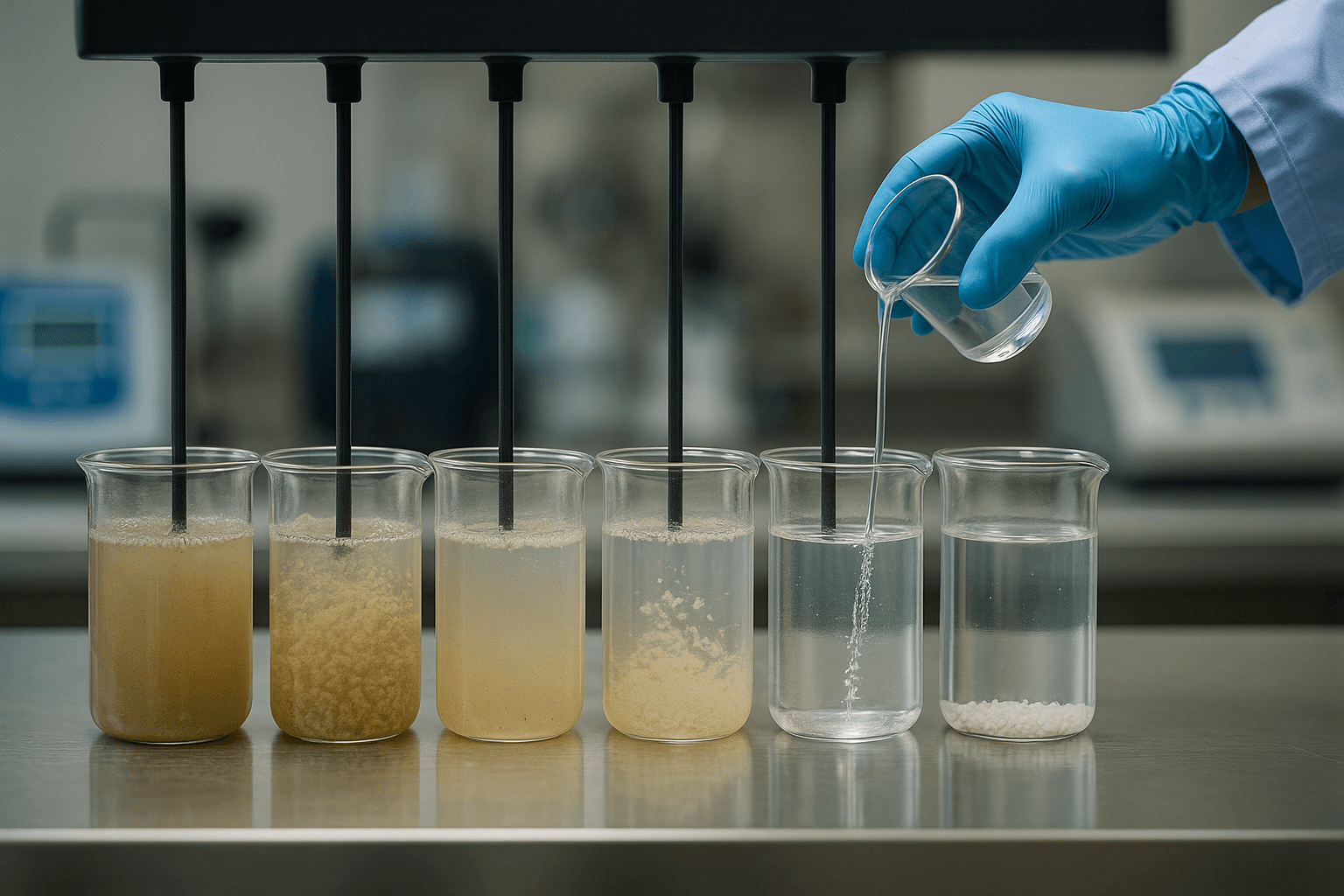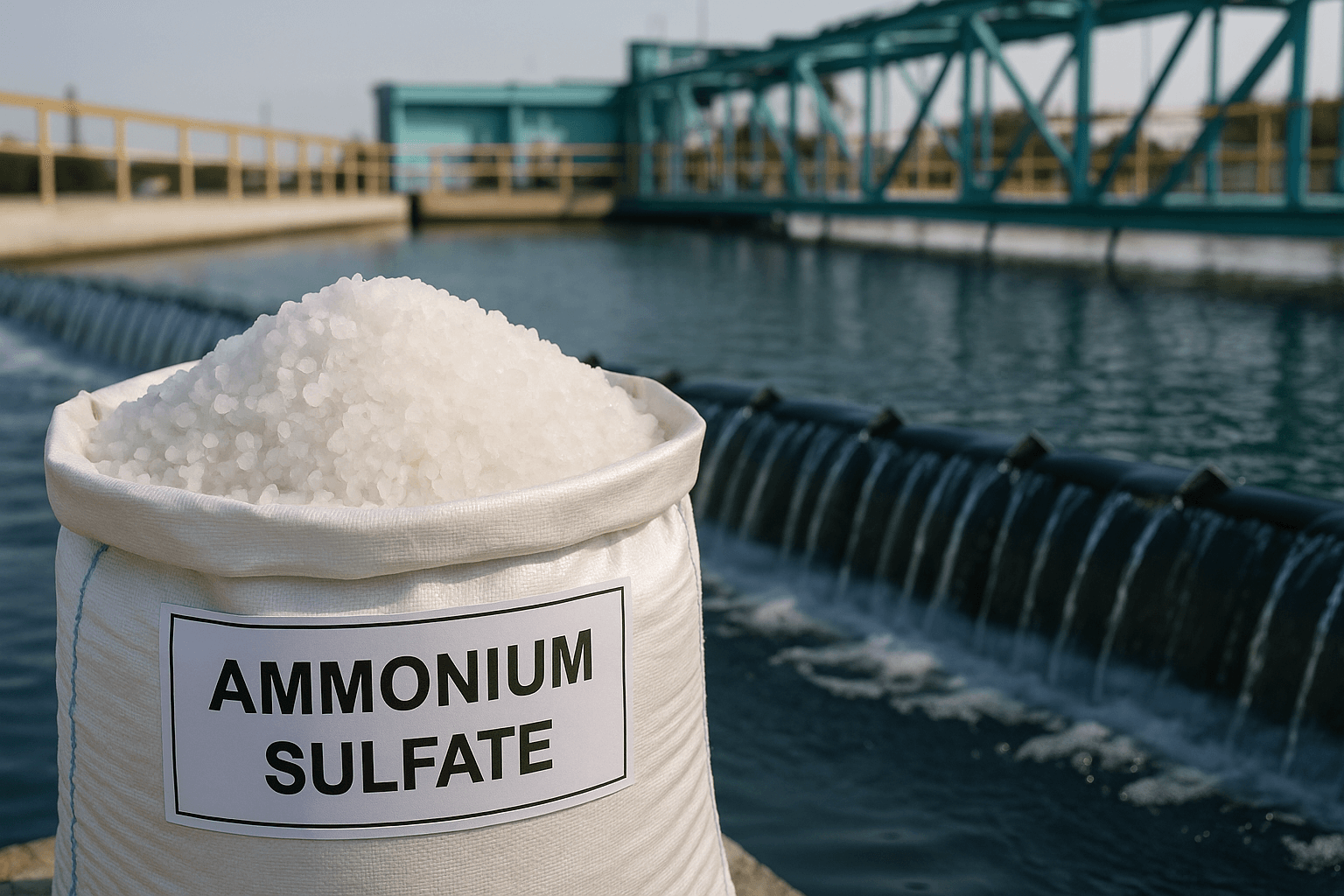Application of Ammonium Sulfate in the Water Treatment Industry

Water is the most vital resource for life, and access to clean and clear water is one of the main concerns of modern societies. With the rapid growth of population and industrial development, water treatment has become a strategic process worldwide. Various chemicals are used to improve water quality and remove impurities, and ammonium sulfate is one of the most important among them.
This chemical compound, in addition to being known as an agricultural fertilizer, also has extensive applications in the treatment of drinking water, municipal wastewater, and industrial effluents. The unique properties of ammonium sulfate, including its ability to coagulate suspended particles, reduce turbidity, and aid in the removal of heavy metals, have given it a special place in the water treatment industry.
Below, we will examine the applications of ammonium sulfate in water treatment more closely, along with its advantages, disadvantages, and comparisons with other similar chemicals.
Why Ammonium Sulfate is Important in Water Treatment
Ammonium sulfate ((NH₄)₂SO₄) is an inorganic compound available in the market as white or colorless crystals. It dissolves rapidly in water and has a mildly acidic pH, making it an effective option in many chemical processes related to water treatment.
One of the main reasons for using ammonium sulfate in water treatment is its ability to coagulate and flocculate suspended particles. When added to water, it initiates chemical reactions that cause fine suspended and colloidal particles to stick together, forming larger clumps (flocs) that settle. This process significantly reduces water turbidity and improves its visual and hygienic quality.
In addition, ammonium sulfate can help reduce water hardness. The presence of ammonium and sulfate ions helps neutralize certain alkaline compounds, balancing the water pH. This is especially important in areas with hard water.
Another important point is that ammonium sulfate is safer compared to some similar chemicals, such as aluminum sulfate (Alum), and its storage and transportation pose fewer risks.
Applications of Ammonium Sulfate in the Water Treatment Industry
The application of ammonium sulfate is not limited to agriculture; it is a key chemical in the water treatment industry. Depending on the type of water source (municipal, industrial, or agricultural), the role and function of this compound can vary.
1. Municipal Drinking Water Treatment
In municipal systems, water must be free from turbidity, heavy metals, and microbial contamination. Ammonium sulfate is used as a coagulant aid, helping suspended and colloidal particles to coagulate and settle. This results in clearer water suitable for human consumption.
Additionally, ammonium sulfate helps reduce alkalinity, adjusting the water pH to within the standard range. In many countries, municipal water treatment plants use it alongside chemicals like aluminum sulfate or polyaluminum chloride (PAC) to enhance system efficiency.
2. Industrial Wastewater Treatment
One of the main challenges in industries such as textiles, petrochemicals, food, and pharmaceuticals is the presence of chemical pollutants in the effluent. Heavy metals such as chromium, lead, and nickel, as well as suspended organic compounds, can cause irreparable damage to ecosystems if discharged untreated.
Ammonium sulfate acts as a precipitating and neutralizing agent in this context. When added to wastewater, it precipitates metal and mineral compounds, allowing them to be separated from the effluent stream.
3. Agricultural Water Treatment (Irrigation)
Water used in agriculture often contains high hardness and alkaline compounds, which reduce soil efficiency and nutrient uptake by plants. Using ammonium sulfate in this context can:
Reduce water hardness
Balance water pH
Improve nutrient absorption in soil
As a result, agricultural products achieve higher quality, and farm productivity increases.
Methods of Using Ammonium Sulfate in Water Treatment
Ammonium sulfate, due to its chemical properties, can be used at various stages of water treatment as a coagulant, hardness reducer, and heavy metal remover. The main methods include:
1. Coagulation & Flocculation
One of the primary uses of ammonium sulfate in water treatment is flocculation of suspended particles. Many particles in water (e.g., soil, clay, bacteria, organic compounds) do not settle naturally due to their electric charge.
Adding ammonium sulfate neutralizes the surface charge of these particles, allowing them to clump together into larger flocs that settle easily in sedimentation tanks. This process is particularly important in municipal drinking water treatment.
2. Water Hardness Reduction
Another major problem in drinking and industrial water is the presence of calcium and magnesium ions, which increase water hardness. High hardness leads to scale formation in pipes, boilers, and industrial equipment.
Ammonium sulfate releases sulfate ions that react with calcium and magnesium, forming insoluble compounds that precipitate, temporarily reducing water hardness and improving water quality.
3. Removal of Heavy Metals from Industrial Wastewater
A significant concern in industrial water treatment is toxic heavy metals like lead (Pb), chromium (Cr), and nickel (Ni). If these elements enter water sources, they are harmful to both the environment and human health.
Ammonium sulfate chemically reacts with these metals, precipitating them as insoluble compounds. This removes heavy metals from the water, enabling safer discharge.
4. Combined Use with Other Chemicals
In many advanced treatment systems, ammonium sulfate is used alongside chemicals like aluminum sulfate (Alum) or polyaluminum chloride (PAC). This combination enhances flocculation and sedimentation efficiency while reducing overall treatment costs.
Advantages and Disadvantages of Using Ammonium Sulfate in Water Treatment
Advantages
High solubility in water: Easily dissolves, suitable for continuous or batch treatment systems.
Safer than some alternatives: Unlike ammonium nitrate, ammonium sulfate is stable under normal conditions, making handling and storage safer.
Effective in coagulation: Excellent for removing suspended particles, bacteria, and turbidity.
Versatile use: Applicable in municipal, industrial, and agricultural water treatment.
Cost-effective: More affordable compared to some imported chemicals.
Disadvantages
Excessive pH reduction: Overuse may lower pH too much, potentially damaging equipment.
Lower nitrogen content: Compared to urea or ammonium nitrate, more may be needed in certain applications.
Higher transportation cost: Due to higher molecular weight and packaging requirements.
Requires precise dosing: Overuse can leave residual sulfate affecting water taste over time.
Comparison with Other Chemicals in Water Treatment
Aluminum Sulfate (Alum):
Both are coagulants and flocculants. Alum may leave residual aluminum at high doses, which can be harmful, whereas ammonium sulfate does not.
Polyaluminum Chloride (PAC):
PAC is more advanced in fine particle coagulation. Ammonium sulfate is cheaper and more accessible, ideal for budget-constrained projects. Often used together to improve efficiency.
Chlorine:
Used mainly for disinfection, not coagulation or hardness reduction. Ammonium sulfate focuses on turbidity and heavy metal removal.
Lime:
Primarily used to raise pH and reduce permanent hardness. Ammonium sulfate acts as a temporary pH and hardness reducer, better for alkaline waters.
Ammonium Nitrate:
High nitrogen content but explosive risk and legal limitations make it hazardous. Ammonium sulfate is safer and more stable.
Environmental Impact and Sustainability of Ammonium Sulfate in Water Treatment
Using chemicals in water treatment raises environmental concerns. Ammonium sulfate is often less hazardous and more stable than other chemicals.
1- Reduced groundwater contamination: Its gradual release of nitrogen and sulfate lowers nitrate leaching risk.
2- Compatibility with sustainable agriculture: Treated wastewater containing ammonium sulfate can be reused as secondary fertilizer, reducing disposal costs and supporting nutrient recycling.
3- Impact on aquatic ecosystems: Overuse may increase sulfate ions in surface water, affecting sensitive ecosystems. Proper dosing is critical.
4- Reduced greenhouse gas emissions: Unlike some chemicals, it does not significantly increase greenhouse gas release.
5- Safe storage and disposal: Safer than many alternatives, and effluents can often be managed without serious environmental harm.
Price and Purchase Guide for Ammonium Sulfate in Water Treatment
Selecting the appropriate ammonium sulfate can directly impact water quality and operational costs. Key factors include:
Purity: For sensitive applications like drinking water, >99% purity is recommended.
Country of origin: Iran, China, Turkey, and India are common sources, each with different prices.
Packaging: 25 kg bags for small-scale use; 1000 kg bags for large industries.
Currency and transport fluctuations: Import prices are highly affected by exchange rates.
Purchase Recommendations:
Buy from reputable suppliers providing a Certificate of Analysis (COA).
Ensure the product dissolves easily and is free of insoluble impurities.
For bulk purchases, choose safe and durable packaging for transportation and storage.
For sensitive projects, select established brands with a track record in water treatment supply.
Why Ammonium Sulfate is the Best Choice for Water Treatment
Ammonium sulfate is a strategic chemical in water treatment. By providing nitrogen and sulfate, aiding in flocculation, improving water quality, and offering high safety compared to alternatives, it is a preferred option in treatment plants.
The Ammonium Sulfate brand offers high-purity products, competitive pricing, and standard packaging, making it a reliable choice for companies and industries in water and wastewater management.
If you want to improve water quality, reduce operational costs, and ensure reliable water treatment, contact our specialists today for professional consultation and sustainable supply.
References:
FAO – Fertilizer and Water Quality
🔗 https://www.fao.org/land-water/water/waterqualityWHO – Guidelines for Drinking-water Quality
🔗 https://www.who.int/water_sanitation_healthEPA – Water Treatment Processes
🔗 https://www.epa.gov/dwreginfo/drinking-water-treatment


